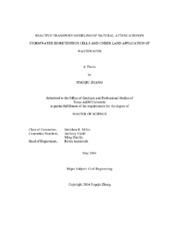| dc.description.abstract | Natural attenuation is a cost effective method to treat wastewater applied into
soil. The natural attenuation process includes diffusion, dispersion, microbial activity,
oxidation, mineral precipitation, sorption, and ion exchange to mitigate hydrocarbon,
nutrient, metals, and solids. Vegetation also plays an important role in reducing water
volume, and removing nutrients and solutes from the contaminated soil. We used a
reactive transport model MIN3P-THM to simulate the natural attenuation on stormwater
runoff, and oil and gas produced wastewater.
In bioretention systems, the model results indicated that the bioretention systems
were able to remove most of heavy metals, nitrate, and organic carbon through natural
attenuation in the soil. Due to macropores and fast flow paths created by roots in
vegetated cells, the water can carry ions flowing out of the system very quickly leading
to a higher outflow rate and less removal efficiency than non-vegetated cells. The model
also tested a range of possible design configurations to determine the optimal saturated
zone thickness and outlet location for nitrate removal. In addition, different rainfall
levels did influence the natural attenuation performance of bioretention cells under long
time application. Due to less water and chemical input, climate patterns may lead to
better removal of heavy metals.
For land application of Oil and Gas Exploration and Production wastewater, five
scenarios were developed to study the impact of chloride, salts, and organic matters on
natural attenuation. Water and salinity stress were considered in the model to deal with
high salinity wastewater in the root zone. For High-FDS and High-Cl treatments, long time application of high salinity wastewater did accumulate salts in the root zone and affect groundwater quality. Under the High-TOC treatment, TOC begins to build up in the root zone in concentrations up to 750 mg/L. More attention should be paid on long-term land application of high salinity wastewater; the application process may pollute groundwater and nearby rivers causing human health hazard. Plants would reduce water uptake to survive themselves when water and solute stress occurred under high salinity conditions. | en |


